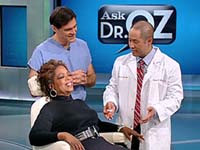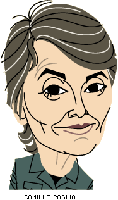 Remember when Bill Moyers showed brain surgery being performed in the early 1990s with acupuncture as the sole form of anesthesia on his PBS series “Healing and the Mind?” American acupuncturists point to that televised moment as the beginning of America’s receptivity to this centuries-old Chinese healing method.
Remember when Bill Moyers showed brain surgery being performed in the early 1990s with acupuncture as the sole form of anesthesia on his PBS series “Healing and the Mind?” American acupuncturists point to that televised moment as the beginning of America’s receptivity to this centuries-old Chinese healing method.
Well, yesterday Oprah Winfrey gave acupuncture its second most resounding endorsement on her TV show.
How surprising, given the sophisticated healing circles Oprah hangs in, that she’s never been “needled”! But yesterday, the big O reclined in a cushy dentist’s chair and submitted to her first mini-treatment, allowing an acupuncturist to insert into her hand and leg fine filaments (they’re so delicate it’s too bad people call them “needles” at all). Oprah flinched a bit (for comedic effect) but experienced no pain. Then a studio audience member in steady shoulder discomfort went backstage for a full session, emerging pain-free at the program’s end. (A licensed acupuncturist ordinarily takes a full health history before any work begins. Don’t go to anyone who doesn’t!)
Oprah’s session was overseen by adorable celebrity cardiologist Mehmet Oz, M.D. Toward the end of the powerfully informative program, Oz turned to Oprah, leaned forward, and said: “But let’s broaden the discussion, because it’s not just about acupuncture. The reason I’m so excited and passionate about alternative medicine is [because it is] the globalization of medicine… We’re beginning now to understand things that we know in our hearts are true but we could never measure. As we get better at understanding how little we know about the body, we begin to realize that the next big frontier… in medicine is energy medicine. It’s not the mechanistic part of the joints moving. It’s not the chemistry of our body. It’s understanding for the first time how energy influences how we feel.”
I’m guessing that the thousands of people devoting their lives to energetic healing modalities like homeopathy, Reiki, osteopathy, and more, would have applauded the moment if they’d been watching, maybe even cried over it. The general public is clearly receptive, though more research is needed. And the practitioners involved with root-cause healing and preventative medicine are more vocal and visible than ever.

